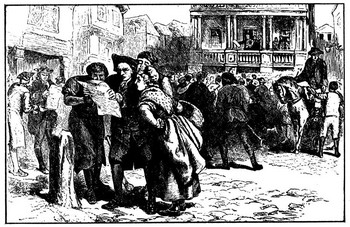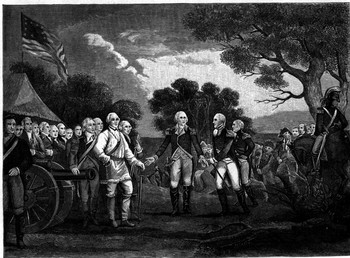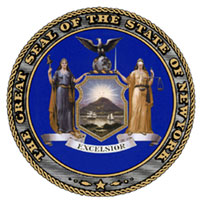The
Making of the 50 States: New York
|
Share This Page
|
|
|
|
|
|
|
Follow This Site

|
 |
|
|
|
|

|
Part 2: War, Taxes, and Peace
That same year, 1754, war erupted between England and France. This was the French and Indian War, and English settlers from New York volunteered or were pressed into service in this war (including a young George Washington). A number of important battles in this war took place in New York, including those for Crown Point, Fort Niagara, Fort Frontenac, and Fort Ticonderoga. New York shared a border with Canada, and that border was the focus of much struggle throughout the nine years of the war.
The end of the war cemented British dominance of the North American continent. It also created a lot of debt. American soldiers fought on the side of the British in the French and Indian War. They supplied food and weapons of their own, not to mention quarters for soldiers both American and British. But the British government also did a lot of borrowing, from banks in Britain and from banks abroad. By the time the war ended, Britain was in charge of not only the American colonies but also a huge chunk of new land (namely, Canada). And accompanying this new set of responsibilities was a large bill.
Rightly or wrongly, the British government decided that the American colonists should pay a large part of the war debt. It was their land, after all, that all those British troops had been defending. So, the British government introduced a series of taxes, both at home and abroad. Naturally, the new taxes weren't too well  received in either place. One of the chief beefs from the American colonists, though, was that they hadn't been given any kind of say in the structure or size of those taxes. Now, it could be argued that British citizens living Britain didn't much of a say in the structure or size of the taxes imposed on them, either. But the American colonists thought that at least the British citizens were represented in Parliament by people who lived in their districts. The only contact the American colonists had with Parliament was the receiving end of whatever pronouncements and taxes came their way. The British government was determined to pass these taxes, and so it is doubtful that even if the American colonists had had representation in Parliament they would have been able to forestall the passage of these taxes. But one thing that the British government didn't anticipate was the vehemence with which these taxes were received.
received in either place. One of the chief beefs from the American colonists, though, was that they hadn't been given any kind of say in the structure or size of those taxes. Now, it could be argued that British citizens living Britain didn't much of a say in the structure or size of the taxes imposed on them, either. But the American colonists thought that at least the British citizens were represented in Parliament by people who lived in their districts. The only contact the American colonists had with Parliament was the receiving end of whatever pronouncements and taxes came their way. The British government was determined to pass these taxes, and so it is doubtful that even if the American colonists had had representation in Parliament they would have been able to forestall the passage of these taxes. But one thing that the British government didn't anticipate was the vehemence with which these taxes were received.
New York might not have had the Boston Tea Party, but it did have its instances of tarring and feathering and it certainly had its instances of irate taxpayers voicing their opposition to taxes in the streets, in meeting halls, and to anyone else who would listen. New York City and Albany, as two of the larger cities in the colonies, were focal points for protests against the series of taxes that didn't seem to have an end.
Yes, New Yorkers played a part in getting the Stamp Tax repealed. Yes, they spoke out against the Sugar Tax and the Tea Tax and the Intolerable Acts. Yes, they sent delegates to the Continental Congress. Yes, they participated fully in the Revolutionary War.
Like other colonies, New York had a population divided between revolutionaries and Loyalists. New York also had a large number of British soldiers in it most of the time. During the Revolutionary War, New York City was occupied and most of the southern Hudson Valley controlled by British soldiers and representatives. A major exception to this was the American garrison at West Point. Benedict Arnold, hero of the French and Indian War and the Battle of Fort Ticonderoga but disillusioned with his current lack of respect, tried to hand the keys to West Point over to the British, but his plot was discovered and his command stripped. Arnold would later serve as a British commander and be forever labeled a traitor to the American cause.
A handful of significant battles were fought in the New York colony. The first two were the Battle of Brooklyn and the Battle of White Plains. Both were won by the British, and both involved daring escapes by American commander in chief George Washington.
 The most famous battle to take place in New York, however, was the Battle of Saratoga. The resulting American victory was a huge boost, to American morale and to European confidence in the Americans' ability to construct a spirited defense of their homeland. The result wasn't an immediate withdrawal of all British troops in the New York colony, however. That occupation continued until the end of the war.
The most famous battle to take place in New York, however, was the Battle of Saratoga. The resulting American victory was a huge boost, to American morale and to European confidence in the Americans' ability to construct a spirited defense of their homeland. The result wasn't an immediate withdrawal of all British troops in the New York colony, however. That occupation continued until the end of the war.
New York, as a colony with a very large population, played a leading role in the government-forming operations that followed the Revolutionary War. Particularly important were the efforts of Alexander Hamilton, John Jay, and James Madison to convince the people of New  York to ratify the new Constitution. (These were the Federalist Papers, a series of anonymous letters to newspapers, describing the merits of the new form of government.) On July 26, 1788, New York became the 11th state to ratify the Constitution, and the State of New York was born.
York to ratify the new Constitution. (These were the Federalist Papers, a series of anonymous letters to newspapers, describing the merits of the new form of government.) On July 26, 1788, New York became the 11th state to ratify the Constitution, and the State of New York was born.
First page > In the Beginning > Page 1, 2
|



 received in either place. One of the chief beefs from the American colonists, though, was that they hadn't been given any kind of say in the structure or size of those taxes. Now, it could be argued that British citizens living Britain didn't much of a say in the structure or size of the taxes imposed on them, either. But the American colonists thought that at least the British citizens were represented in Parliament by people who lived in their districts. The only contact the American colonists had with Parliament was the receiving end of whatever pronouncements and taxes came their way. The British government was determined to pass these taxes, and so it is doubtful that even if the American colonists had had representation in Parliament they would have been able to forestall the passage of these taxes. But one thing that the British government didn't anticipate was the vehemence with which these taxes were received.
received in either place. One of the chief beefs from the American colonists, though, was that they hadn't been given any kind of say in the structure or size of those taxes. Now, it could be argued that British citizens living Britain didn't much of a say in the structure or size of the taxes imposed on them, either. But the American colonists thought that at least the British citizens were represented in Parliament by people who lived in their districts. The only contact the American colonists had with Parliament was the receiving end of whatever pronouncements and taxes came their way. The British government was determined to pass these taxes, and so it is doubtful that even if the American colonists had had representation in Parliament they would have been able to forestall the passage of these taxes. But one thing that the British government didn't anticipate was the vehemence with which these taxes were received. The most famous battle to take place in New York, however, was the
The most famous battle to take place in New York, however, was the  York to ratify the new Constitution. (These were the
York to ratify the new Constitution. (These were the 
